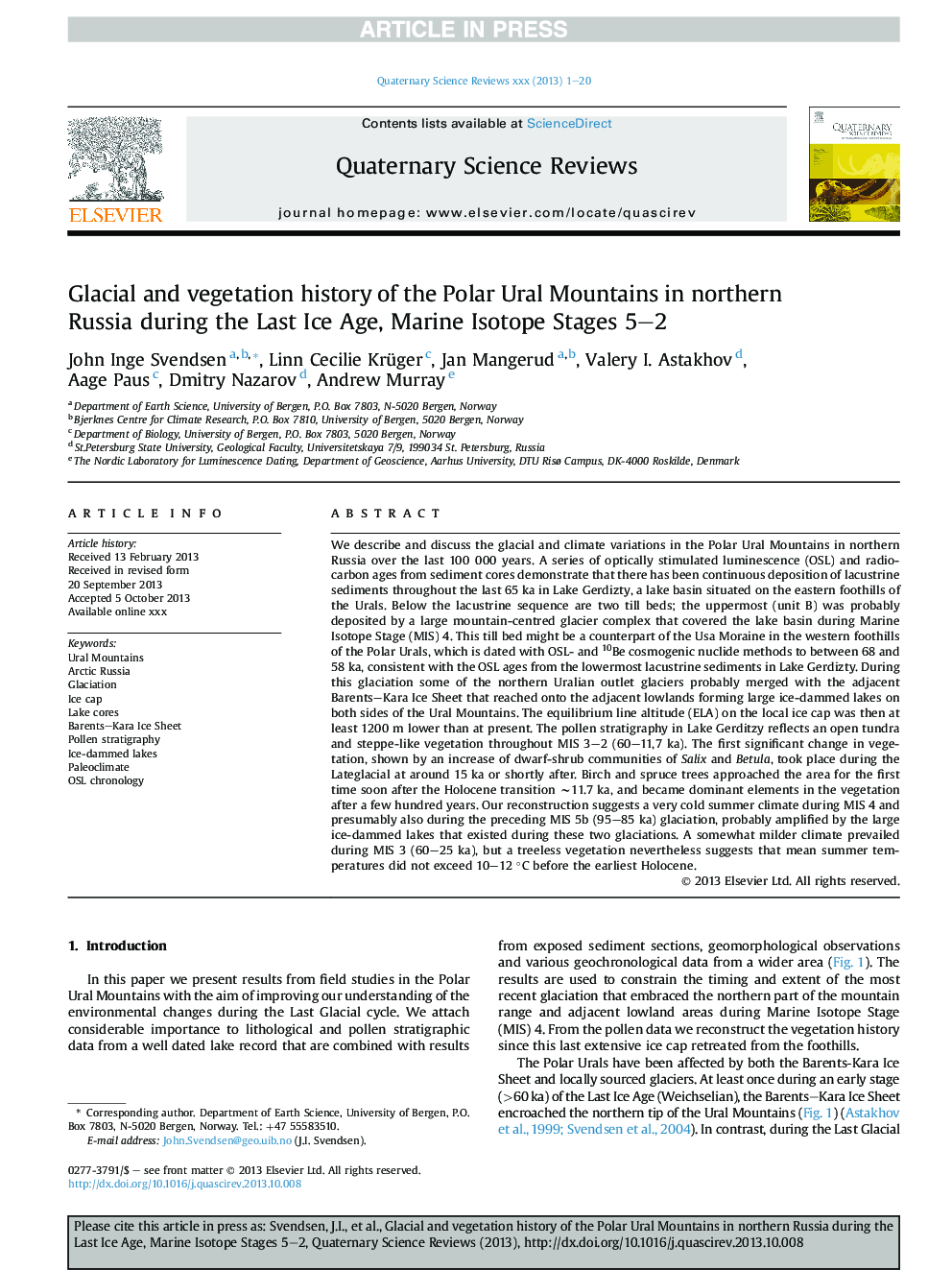| کد مقاله | کد نشریه | سال انتشار | مقاله انگلیسی | نسخه تمام متن |
|---|---|---|---|---|
| 6446381 | 1640842 | 2014 | 20 صفحه PDF | دانلود رایگان |
عنوان انگلیسی مقاله ISI
Glacial and vegetation history of the Polar Ural Mountains in northern Russia during the Last Ice Age, Marine Isotope Stages 5-2
ترجمه فارسی عنوان
تاریخچه یخبندان و گیاهان کوههای قطبی اورال در شمال روسیه در طول عصر یخبندان، مراحل ایزوتوپ دریایی 5-2
دانلود مقاله + سفارش ترجمه
دانلود مقاله ISI انگلیسی
رایگان برای ایرانیان
کلمات کلیدی
موضوعات مرتبط
مهندسی و علوم پایه
علوم زمین و سیارات
زمین شناسی
چکیده انگلیسی
We describe and discuss the glacial and climate variations in the Polar Ural Mountains in northern Russia over the last 100 000 years. A series of optically stimulated luminescence (OSL) and radiocarbon ages from sediment cores demonstrate that there has been continuous deposition of lacustrine sediments throughout the last 65 ka in Lake Gerdizty, a lake basin situated on the eastern foothills of the Urals. Below the lacustrine sequence are two till beds; the uppermost (unit B) was probably deposited by a large mountain-centred glacier complex that covered the lake basin during Marine Isotope Stage (MIS) 4. This till bed might be a counterpart of the Usa Moraine in the western foothills of the Polar Urals, which is dated with OSL- and 10Be cosmogenic nuclide methods to between 68 and 58 ka, consistent with the OSL ages from the lowermost lacustrine sediments in Lake Gerdizty. During this glaciation some of the northern Uralian outlet glaciers probably merged with the adjacent Barents-Kara Ice Sheet that reached onto the adjacent lowlands forming large ice-dammed lakes on both sides of the Ural Mountains. The equilibrium line altitude (ELA) on the local ice cap was then at least 1200 m lower than at present. The pollen stratigraphy in Lake Gerditzy reflects an open tundra and steppe-like vegetation throughout MIS 3-2 (60-11,7 ka). The first significant change in vegetation, shown by an increase of dwarf-shrub communities of Salix and Betula, took place during the Lateglacial at around 15 ka or shortly after. Birch and spruce trees approached the area for the first time soon after the Holocene transition â¼11.7 ka, and became dominant elements in the vegetation after a few hundred years. Our reconstruction suggests a very cold summer climate during MIS 4 and presumably also during the preceding MIS 5b (95-85 ka) glaciation, probably amplified by the large ice-dammed lakes that existed during these two glaciations. A somewhat milder climate prevailed during MIS 3 (60-25 ka), but a treeless vegetation nevertheless suggests that mean summer temperatures did not exceed 10-12 °C before the earliest Holocene.
ناشر
Database: Elsevier - ScienceDirect (ساینس دایرکت)
Journal: Quaternary Science Reviews - Volume 92, 15 May 2014, Pages 409-428
Journal: Quaternary Science Reviews - Volume 92, 15 May 2014, Pages 409-428
نویسندگان
John Inge Svendsen, Linn Cecilie Krüger, Jan Mangerud, Valery I. Astakhov, Aage Paus, Dmitry Nazarov, Andrew Murray,
